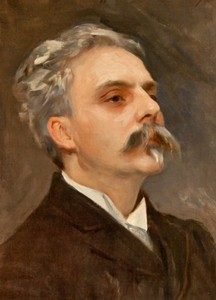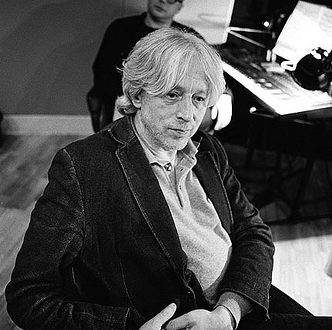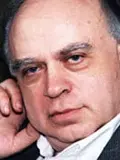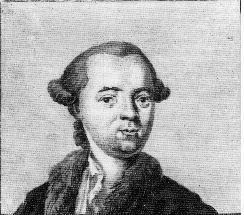
Gabriel Fauré |
Gabriel Fauré
Faure. F.p. quartet in c-moll No. 1, op.15. Allegro molto moderato (Guarneri Quartet and A. Rubinstein)
Great music! So clear, so pure, and so French, and so human! R. Dumesnil
Fauré’s class was for musicians what Mallarme’s salon was for poets… The best musicians of the era, with few exceptions, passed through this wonderful school of elegance and taste. A. Roland-Manuel

The life of G. Faure – a major French composer, organist, pianist, conductor, music critic – took place in an era of significant historical events. In his activity, character, style features, the features of two different centuries were fused. He took part in the last battles of the Franco-Prussian war, witnessed the events of the Paris Commune, heard evidence of the Russian-Japanese war (“What a massacre between the Russians and the Japanese! This is disgusting”), he survived the First World War. In art, impressionism and symbolism flourished before his eyes, the Wagner festivals in Bayreuth and the Russian Seasons in Paris took place. But the most significant was the renewal of French music, its second birth, in which Fauré also took part and in which the main pathos of his social activity was.
Fauré was born in the south of France to a school mathematics teacher and the daughter of a captain in the Napoleonic army. Gabriel was the sixth child in the family. Raising in the countryside with a simple peasant-breadwinner formed a silent, thoughtful boy, instilled in him a love for the soft outlines of his native valleys. His interest in music unexpectedly manifested itself in timid improvisations on the harmonium of the local church. The giftedness of the child was noticed and he was sent to study in Paris at the School of Classical and Religious Music. 11 years at the School gave Faure the necessary musical knowledge and skills based on the study of a large number of works, including early music, starting with the Gregorian chant. Such a stylistic orientation was reflected in the work of the mature Faure, who, like many of the greatest composers of the XNUMXth century, revived some of the principles of musical thinking of the pre-Bach era.
Faure was especially given a lot by communication with a musician of enormous scale and exceptional talent – C. Saint-Saens, who taught at the School in 1861-65. A relationship of complete trust and community of interests has developed between the teacher and the student. Saint-Saëns brought a fresh spirit into education, introducing his students to the music of the romantics – R. Schumann, F. Liszt, R. Wagner, until then not well known in France. Faure did not remain indifferent to the influences of these composers, friends even called him sometimes “French Schuman”. With Saint-Saens, a friendship began that lasted a lifetime. Seeing the exceptional giftedness of the student, Saint-Saens more than once trusted him to replace himself in some performances, later he dedicated his “Breton Impressions” for organ to him, used Fauré’s theme in the introduction of his Second Piano Concerto. After graduating from the School with first prizes in composition and piano, Fauré went to work in Brittany. Combining official duties in the church with playing music in a secular society, where he enjoys great success, Faure soon loses his place by mistake and returns to Paris. Here Saint-Saens helps him get a job as an organist in a small church.
A significant role in the fate of Foret was played by the salon of the famous singer Pauline Viardot. Later, the composer wrote to her son: “I was received at your mother’s house with kindness and friendliness, which I will never forget. I kept … the memory of the marvelous hours; they are so precious with your mother’s approval and your attention, Turgenev’s ardent sympathy … ”Communication with Turgenev laid the foundation for ties with figures of Russian art. Later, he made acquaintances with S. Taneyev, P. Tchaikovsky, A. Glazunov, in 1909 Fauré came to Russia and gave concerts in St. Petersburg and Moscow.
In Viardot’s salon, Fauré’s new works were often heard. By this time, he had composed a large number of romances (including the famous Awakening), which attracted listeners with melodic beauty, subtlety of harmonic colors, and lyrical softness. The violin sonata evoked enthusiastic responses. Taneyev, having heard her during his stay in Paris, wrote: “I am delighted with her. Perhaps this is the best composition of all those that I have heard here … The most original and new harmonies, the most daring modulations, but at the same time nothing sharp, annoying the ear … The beauty of the topics is amazing … “
The personal life of the composer was less successful. After breaking off the engagement with the bride (Viardot’s daughter), Foret experienced a severe shock, the consequences of which he got rid of only after 2 years. The return to creativity brings a number of romances and the Ballade for Piano and Orchestra (1881). Developing the traditions of Liszt’s pianism, Faure creates a work with expressive melody and almost impressionistic subtlety of harmonic colors. Marrying the daughter of the sculptor Fremier (1883) and calming down in the family made Foret’s life happier. This is reflected in the music as well. In piano works and romances of these years, the composer achieves amazing grace, subtlety, and contemplative satisfaction. More than once, crises associated with severe depression and the onset of a disease so tragic for a musician (hearing disease) interrupted the composer’s creative path, but he emerged victorious from each, presenting more and more evidence of his outstanding talent.
Fruitful for Fauré was an appeal to the poetry of P. Verlaine, according to A. France, “the most original, the most sinful and the most mystical, the most complex and most confused, the most insane, but, of course, the most inspired, and the most genuine of modern poets” (about 20 romances, including the cycles “From Venice” and “Good Song”).
The greatest successes accompanied Faure’s favorite chamber genres, on the basis of the study of which he built his classes with students in the composition class. One of the peaks of his work is the magnificent Second Piano Quartet, full of dramatic collisions and excited pathos (1886). Fauré also wrote major works. During the Second World War, his opera “Penelope” (1913) sounded with special meaning for the French patriots, many researchers and admirers of Fauré’s work consider him a masterpiece Requiem with the soft and noble sorrow of his chants (1888). It is curious that Faure took part in the opening of the first concert season of the 1900th century, composing music for the lyrical drama Prometheus (after Aeschylus, 800). It was a colossal undertaking in which approx. XNUMX performers and which took place in the “French Bayreuth” – an open-air theater in the Pyrenees in southern France. At the time of the dress rehearsal, a thunderstorm broke out. Faure recalled: “The storm was terrifying. Lightning fell into the arena right into the place (what a coincidence!), where Prometheus was supposed to strike a fire … the scenery was in a deplorable state. However, the weather improved and the premiere was a resounding success.
Fauré’s social activities were of great importance for the development of French music. He takes an active part in the activities of the National Society, designed to promote the musical art of France. In 1905, Fauré took the post of director of the Paris Conservatoire, and the future flourishing of her activity is undoubtedly the result of the renewal of the teaching staff and the reorganizations undertaken by Fauré. Always acting as a defender of the new and progressive in art, Fauré in 1910 did not refuse to become president of the new Independent Musical Society, organized by young musicians not accepted into the National Society, among whom there were many Fauré’s students (including M. Ravel). In 1917, Faure achieved the unification of French musicians by introducing independents into the National Society, which improved the atmosphere of concert life.
In 1935, friends and admirers of Fauré’s work, major musicians, performers and composers, among whom were many of his students, founded the Society of Friends of Gabriel Fauré, which promotes the composer’s music among a wide audience – “so clear, so pure, so French and so human” .
V. Bazarnova





